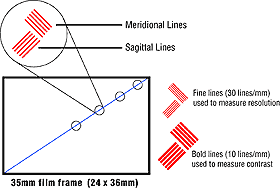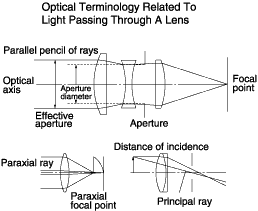| |
| Linear polarizing filter |
 |
|
A filter which only passes light
vibrating in a certain direction. Since the vibrational
locus of the light allowed to pass through the filter is
linear in nature, the filter is called a linear
polarizing filter. This type of filter eliminates
reflections from glass and water the same way as a
circular polarizing filter, but it cannot be used
effectively with most auto exposure and autofocus
cameras as it will cause exposure errors in AE cameras
equipped with TTL metering systems using half-mirrors,
and will cause focusing errors in AF cameras
incorporating AF rangefinding systems using
half-mirrors. | |
|
| |
 Macro lenses Macro lenses
|
 |
|
Macro lenses are essential for
shooting close-ups of flowers, insects and other small
items at life-size magnification or larger. Quality
optical characteristics, sharp definition and true color
fidelity combine to capture the appeal of your subject
with bold realism. |
 Mechanical distance Mechanical distance
|
 |
|
The distance from the front edge of
the lens barrel to the film plane. |
 Micro USM Micro USM |
 |
|
The micro USM is an advanced motor
developed as a "multi-purpose miniature ultrasonic
motor", and its features are as follows.
Advantages over ring-type
USMs
The micro USM carries no lens diameter
restrictions, so it can be incorporated into a wide
variety of lens designs. The stator, rotor and output
gear are integrated into a single compact unit that is
roughly half the size and weight of a ring-type USM. And
the cost is only about 1/3 that of the already
reasonably priced ring-type USM.
Advantages over DC micro
motors
Low-speed, high-torque characteristics
make it possible to set the AF drive gear ratio low
enough to realize quiet drive operation, (roughly 1/4
the level of a DC micro motor). The micro USM also
features excellent start/stop response and control, and
the large holding torque provides superior focus
positioning precision. |
 MTF chart – How to
read MTF chart – How to
read |
 |
 |
MTF charts (short for Modulation
Transfer Function) provide a graph analyzing a lens’
ability to resolve sharp details in very fine sets of
parallel lines, and a lens’ contrast or ability to
provide a sharp transfer between light and dark areas in
sets of thicker parallel lines. Fine repeating line sets
are created parallel to a diagonal line running from
corner to corner of the 35mm frame, directly through the
exact center of the image area. These are called
sagittal lines, sometimes designated “S” on Canon’s MTF
charts. At a 90° angle to these, additional sets of
repeating lines are drawn, called Meridional (or “M”)
line sets. Repeating extremely fine short parallel lines
spaced at 30 lines per millimeter measure the lens’
ability to record fine details, or its resolution. Even
more important in the eyes of many optical designers is
the lens’ contrast capability, which is measured with
thicker sets of parallel repeating lines drawn at 10
lines per millimeter. At first glance, it would appear
that any good lens would record lines running parallel
to a diagonal drawn across the film with the same
accuracy as lines drawn perpendicular to them. However,
in real-world testing, this is often not the case.
Especially in the Meridional direction, faithful
reproduction of fine line sets becomes increasingly
difficult as you move away from the center of the image
toward one of the corners. And it’s a fact that almost
all lenses produce sharper results in general near the
center of the frame than at the outer edges. MTF charts
display the lens’ performance from center to corner.
Running along the chart’s horizontal axis, labeled 0 to
over 20, is the distance from the dead center (“0”) of a
35mm image along a diagonal line to the corner of the
frame, which is about 21.5mm away. On the chart’s
vertical axis is a scale representing the degree of
accuracy with which the fine and coarse line sets are
reproduced, in both the sagittal (parallel to the
diagonal of the film format) and meridonal directions.
Solid lines on the MTF charts indicate the performance
of sagittal lines (parallel to the diagonal of the
film), dashed lines are for the perpendicular meridional
test target lines. In theory, a perfect lens would
produce nothing but straight horizontal lines across the
very top of an MTF chart, indicating 100% accurate
reproduction from the center of the picture (toward the
left of the chart) to its outermost corners (at the
right side of the chart). Of course, no such thing as a
perfect lens exists from any SLR manufacturer, so MTF
charts typically show lines that tend to curve downward
as they move left to right (tracking the lens’
performance from center to corner of the frame). Canon’s
MTF charts give results at two apertures: wide-open, and
stopped down to f/8, with the lens set to infinity
focus. While MTF charts don’t include many factors that
can be important when selecting a lens (size, cost,
handling, closest focusing distances, AF speed, linear
distortion, evenness of illumination, and of course
features like Image Stabilization which may produce
superior real-world results), they can indicate to the
knowledgeable reviewer some of the optical
characteristics they can expect from a particular lens.
|
 Near-sightedness Near-sightedness |
 |
|
The eye condition in which the image
of an infinitely distant point is formed in front of the
retina when the eye is in the accommodation rest state.
|
 Normal vision,
emmetropia Normal vision,
emmetropia |
 |
|
The eye condition in which the image
of an infinitely distant point is formed on the retina
when the eye is in the accommodation rest state.
|
 Numerical aperture
(NA) Numerical aperture
(NA) |
 |
|
A value used to express the
brightness or resolution of a lens' optical system. The
numerical aperture, usually indicated as NA, is a
numerical value calculated from the formula
nsin , where 2 , where 2 is the angle
(angular aperture) at which an object point on the
optical axis enters the entrance pupil and n is the
index of reflection of the medium in which the object
exists. Although not often used with photographic
lenses, the NA value is commonly imprinted on the
objective lenses of microscopes, where it is used more
as an indication of resolution than of brightness. A
useful relationship to know is that the NA value is
equal to half the inverse of the F number. For example,
F 1.0 = NA 0.5, F 1.4 = NA 0.357, F2 = NA 0.25, and so
on. is the angle
(angular aperture) at which an object point on the
optical axis enters the entrance pupil and n is the
index of reflection of the medium in which the object
exists. Although not often used with photographic
lenses, the NA value is commonly imprinted on the
objective lenses of microscopes, where it is used more
as an indication of resolution than of brightness. A
useful relationship to know is that the NA value is
equal to half the inverse of the F number. For example,
F 1.0 = NA 0.5, F 1.4 = NA 0.357, F2 = NA 0.25, and so
on. |
 Optical axis Optical axis
|
 |
|
A straight line connecting the center
points of the spherical surfaces on each side of a lens.
In other words, the optical axis is a hypothetical
center line connecting the center of curvature of each
lens surface. In photographic lenses comprised of
several lens elements, it is of utmost importance for
the optical axis of each lens element to be perfectly
aligned with the optical axes of all other lens
elements. Particularly in zoom lenses, which are
constructed of several lens groups that move in a
complex manner, extremely precise construction is
necessary to maintain proper optical axis alignment.
|
 Overall linear
extension Overall linear
extension |
 |
|
The entire lens optical system moves
straight backward and forward when focusing is carried
out. Representative examples of lenses using this type
of focusing include the EF 50mm f/1.8 II and TS-E 90mm
f/2.8. |
 |
  |
 | |
| |
![]()


